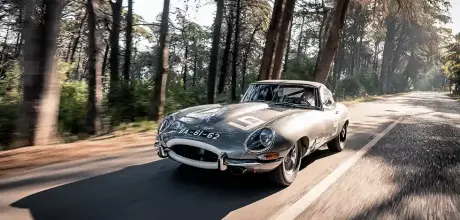1961 Jaguar E-type OTS roadster
Join Octane at Monsanto Park, Portugal, to drive the ex-Manuel Nogueira Pinto 1961 Jaguar E-type racer – the most successful of its era.
Words Richard Heseltine
Photography Luis Duarte Archive images Edições Vintage Archive
JAGUAR AT MONSANTO PARK
The most successful racing E-type of its era
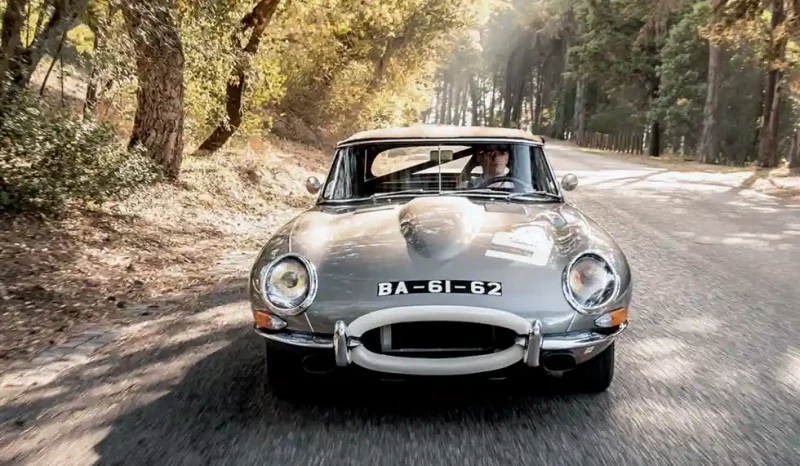
Well, goodness, won’t this be a jolly adventure. It is still dark, but our presence here is causing a sore-thumb resonance for other park-goers. Good morning, please don’t mind us. Jog on by. We will just unload the racing car and fire it up. Locate the kill switch, reconnect this and that, prod the starter and chug, chug, chug… contact! Normally, a Jaguar E-type emits an exhaust note that is crisp and burbly. It isn’t so vulgar as to be loud. Here, not so much. This straight-six is gloriously uproarious, the non-local doing his best to quell the impulse to flex the throttle. That, and to discharge a frothy comment or two.
‘Pinto excelled aboard the E-type during the 1962 season, besting Porsche 550 Spyders and assorted Ferraris’
The backdrop seems so incongruous: an area of protected woodland in central Lisbon bisected by a busy thoroughfare. However, this same spot in the Portuguese capital once resonated to the sound of Grand Prix weaponry, the street circuit having played host to a round of the Formula 1 World Championship in 1959. It is also the venue at which this ‘flat floor’ roadster once vanquished all-comers in the early 1960s. More than once, in fact. This old warhorse saw action in everything from rallies to the Angolan Grand Prix, and is still being raced in anger. Its appearance here is fleeting before it returns to its latter-day home in London.
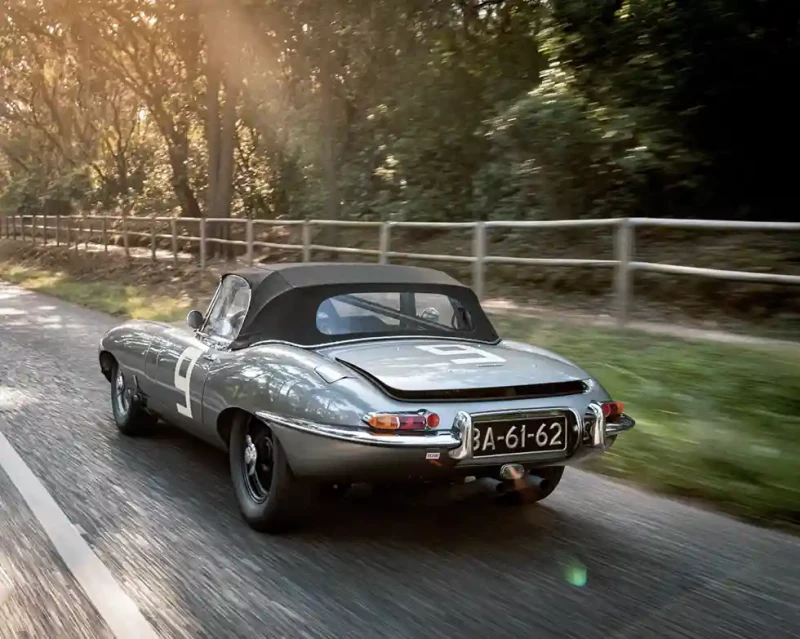
Tellingly, it was a competition tool from the outset; one of the few. As we all know by rote, the E-type caused a media maelstrom following its big reveal, the Malcolm Sayer-penned, Sir William Lyons-refined outline entering into legend in an instant. Redolent of the D-type, not to mention the E1A and E2A prototypes, the E-type showcased the Coventry firm’s sporting intent. It didn’t really matter that the shape wasn’t aerodynamically efficient, or that it suffered from front-end lift at high speed: it looked sensational. To arbiters of beauty, that was all that mattered, even if no E-type production car ever managed to reach 150mph as The Autocar famously did aboard the lightly breathed-on demonstrator.
Even so, it was still mind-bogglingly quick by contemporary standards. Here was a car that was comfortably faster than most vowel-laden exotica, but it also boasted advanced monocoque construction and independent rear suspension. The E-type’s competition debut was a belated one, mind, because Jaguar didn’t manage to supply cars quickly enough for privateer entrants John Coombs and Tommy Sopwith to field them at the Goodwood Easter Meeting in 1961. This was in part due to industrial unrest at the body-making plant. It was left to Graham Hill and Roy Salvadori to ensure the car made an impression in the 25-lap Trophy Race at Oulton Park a few weeks later.

Hill won aboard the Equipe Endeavour entry, with Salvadori third (he led for much of the way, only for his car’s brakes to wilt). As debuts go, it was pretty emphatic. Ferrari thought so: accepted history suggests that the 250 GTO was created as a response to the perceived threat from Coventry. This being the case, ‘The Reds’ needn’t have worried. The E-type never was a great racing car, even the ‘Lightweight’ edition – built specifically for motor racing rather than adapted to fit (and also benefiting from a certain amount of homologation chicanery) – proving no match for the cars from Maranello. As such, the applecart remained upright.
Which isn’t to say that the E-type didn’t enjoy success, but it was mostly at national level. ‘Our’ car is a case in point. According to the Jaguar Daimler Heritage Trust, this ‘Open Top Sports’ was completed on 16 October 1961. Resplendent in Opalescent Silver Grey with a dark blue interior, it was imported by Porto’s Jo.o Gaspar, a well-connected concessionaire for Alfa Romeo and Ferrari, among others. It was the fifth E-type to enter Portugal, arriving with a few tweaks that included a high-compression head. The Jaguar made its competition debut in January 1962, Manuel Nogueira Pinto and Manuel Mocelek placing second overall and first in class on the Rallye Abertura do Sporting.
The car would in time become inextricably linked with Pinto, a true blueblood whose father Jos. had performed effectively on-track a decade earlier aboard an Allard and assorted Ferraris that included a 340 America and a 750 Monza. The younger Pinto first ventured trackside in 1957, ‘Man.’ starting out in a Porsche 356 1500 Carrera GS. A year later, he joined forces with future Grand Prix occasional M.rio Cabral to contest the Nürburgring 1000 Kilometres in an Alfa Romeo Giulietta Sprint. The young noblemen renewed their partnership for the 1959 running, hiring a Scuderia Centro Sud Maserati 300S.

They placed a creditable eighth overall. The two were great friends early on, less so as their careers diverged, and Pinto made little effort to establish himself on the world stage whereas Cabral pursued drives at international level (or at least he did when he wasn’t creating merry hell in Europe’s fleshpots). Nevertheless, Pinto excelled aboard the E-type during the 1962 season, claiming honours at the Montes Claros circuit (the shorter version of the Monsanto Park track used in Formula 1). He bested a pair of Porsche 550 Spyders and a 718 RSK in the process, not to mention assorted Ferraris and other exotica. That same year also included victory at the Louren.o Marques (now Maputo) circuit in Mozambique.
The following season saw Pinto steer the increasingly well-developed Jaguar to repeat honours at Montes Claros. He also contested the Angolan Grand Prix meeting, claiming outright honours in the GT support race while dropping out of the Grand Prix itself. For reasons lost to time, the car was fielded with the rear wire wheels painted black. It was also campaigned with the hood in place (as were all E-type roadsters, it seems), while the boot-lid was invariably propped open: it was deemed the most efficient way of dissipating heat generated by the diff and inboard disc brakes. In addition, ventilation holes were drilled into the boot floor, a demon tweak initiated by Palma & Morgardo, an outfit that enjoyed great success on-track later that decade with assorted Lotus models.
The 1963 season marked the end of the Jaguar’s frontline racing career, while Pinto’s stop-start calling stretched to Formula Vee and national sports-prototype titles before the decade was over. He shone in cars as diverse as a Lotus Elan S3 and a Porsche 908, an Alfa Romeo 2000 GTAm and a GRD S73 sports-racer.
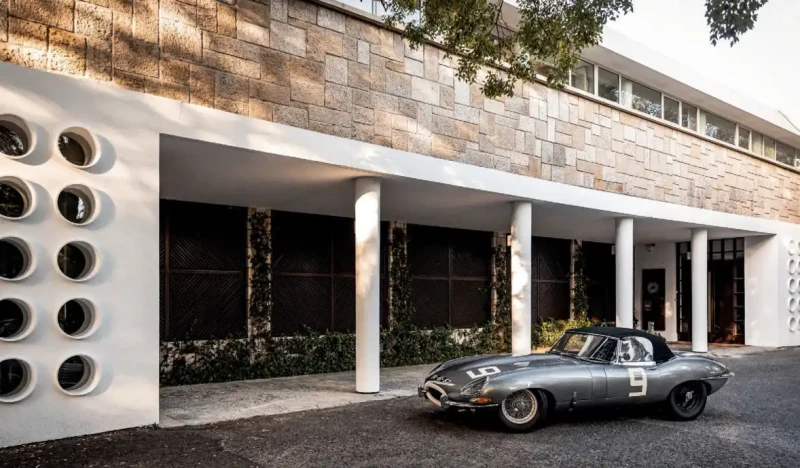
It was aboard the latter that he placed second in Mo.amedes, Angola, in March 1974, after which the father of four hung up his helmet. Regarded as one of the finest Portuguese drivers of the pre-Revolution era, Pinto survived competing at some of the most daunting venues ever to host a motor race, only to die in a house fire in 1981. He was 46.
Scrolling forwards in the narrative, the E-type was acquired by British competitor Marc Gordon in 2019. Prepared by Nick Finburgh, who shares the car in endurance events, it is every inch the weapons-grade historic racer, and one that is immaculate from stem to stern. However, revelling in the attention to detail will have to wait because time is getting short.
By 7am you won’t be able to move here, such is the traffic expected on this section of what was once the home straight of the Montes Claros circuit. It is at this juncture that a slight problem threatens to end play before it has begun: the race seat is fixed and the disparity in dimensions between its owner/driver and the guest pilot becomes an issue.
Repeat instructions to stop dawdling, time being of the essence and all that, leads to a degree of contortion that your average practitioner of yoga can only dream of. This situation isn’t aided by the close proximity of the chunky roll-cage, but mutterings of discomfort are banished on waking the strident straight-six from its slumber. It sounds angry. The photographer and our minder/fixer/ explainer-in-chief then hurriedly point out where to join the old track, or at least the bits that are left intact. Letting in the competition clutch allows no room for slippage. It is either in or out, which rather focuses your attention as you slot into the ebb and flow of early-morning traffic.
The E-type experience threatens to slide from the poetic to the pathetic as the rush-hour car-conga worsens. Hectoring commuters see no reason to deviate from their chosen line, even if it means encroaching on yours, moped riders cheating death as they divebomb you from all sides before randomly braking. There is plenty to ponder, but strangely not the transmission.
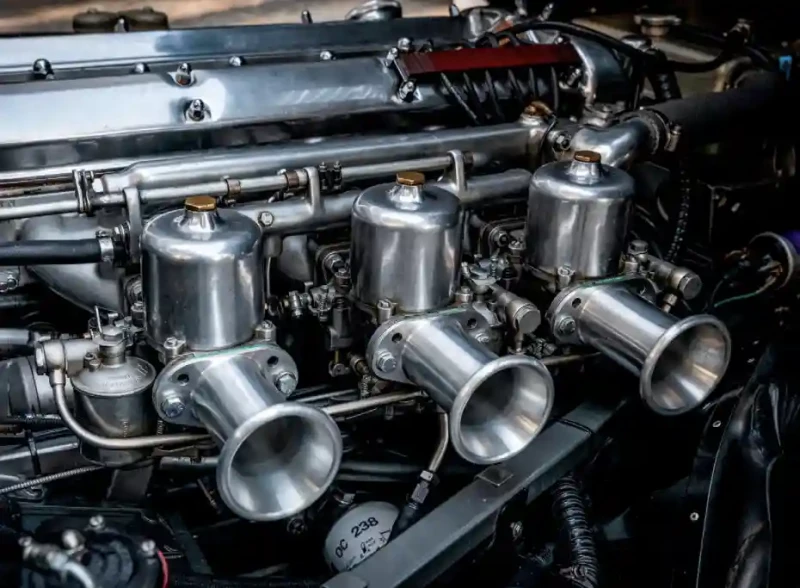
Expecting a battle of wills, early E-type ’boxes being slow-witted on downshifts, here the ‘Moss-plus’ set-up employed on many race examples these days is a joy. You are certainly aware that it has slotted into gear, such is the pronounced ker-klunk. The spine-compressing sliver of carbonfibre that doubles as a seat is less pleasant, mind, but you can forgive this car anything for the fanfare projecting from the back pipes.
Having taken a time-out and allowed the car (and driver) to cool down, we are off to another section of this historic venue, one that is mercifully free of other road users. It also has a decent straight and testy corners. Given room to stretch its legs a little, the E-type just bolts, barking its impending arrival as the revs rise. This is perhaps the biggest surprise of all. You don’t remember Jaguar sixes being quite so free-spinning. Throttle response is immediate, pedal pressure being way lighter than you might imagine. The precise horsepower figure is a mystery, but we would surmise that it is a wee bit north of the original 265bhp (gross) at 5500rpm.
This is not a car that is happy being shunted back and forth, as is to be expected, but it is in its element once given freer reign. You tend to forget how small E-types are, if only by today’s standards when even the diddiest of sports cars appear elephantine in comparison.
Everything is so wonderfully intimate, the steering being well-weighted, lively and responsive. To use parlance du jour, it is analogue and all the better for it. The car is never less than communicative, and it’s agile when you want it to be. Prior experience of E-types tells you that it will be throttle-adjustable and transition keenly from apex to apex. However, this is a public road and there are speed limits.
Some way off ten-tenths, this fabulous machine is a thing of wonder all the same – only the compromised seating position detracts. That, and perhaps the brakes. The impressive-looking vented disc set-up no doubt works brilliantly on a circuit once red-hot, but not so much on the public highway when cold. It’s a car that would be better-served by a longer acquaintanceship but even the briefest of dalliances proves enlightening. It serves to dampen a few well-nurtured prejudices. Even if you are inured to all things E-type through overfamiliarity, the hardest of hearts will have a hairline crack after experiencing this car.
Of course, the location helps, even if the Monsanto Park of today is a spectral echo of the former motorsport venue. It was Pinto’s happy hunting ground, which speaks volumes about his talent as a driver. That, and the car in which he claimed some of his most celebrated victories. Travelling flat-chat here in the E-type must have been eye-widening given the elevation changes, drop-offs, and the small matter of all the trees and other immovable objects. Six decades later, your brain works hard to make sense of it, even if there is little sense to be found.
THANKS TO Marc Gordon and Adelino Dinis.
TECHNICAL DATA 1961 Jaguar E-type OTS roadster
- Engine 3781cc DOHC straight-six, alloy head, triple SU HD8 carburettors
- Max Power 265bhp at 5500rpm
- Max Torque 260lb ft @ 4000rpm
- Transmission Four-speed manual, rear-wheel drive
- Steering Rack and pinion
- Suspension Front: double wishbones, torsion bars, telescopic dampers, anti-roll bar. Rear: lower wishbones, radius arms, fixed-length driveshafts, twinned coil springs and telescopic dampers, anti-roll bar
- Brakes All Discs
- Weight 1219kg
- Top speed 145mph (est)
- Acceleration 0-62mph 6.4 seconds (est)

Right and below Open boot-lid promotes cooling for inboard rear disc brakes and differential – looks great, too; small-diameter wheel is a clue to E-type’s racing past. Above E-type still wears its rear wheels painted black, as they were back in 1963 – it will soon return to London from Portugal.
Clockwise, from left Glorious triple-carb twin-cam straight-six now suspected to be capable of more than the ‘book’ 265bhp; as Circuito de Montes Claros, this pretty Lisbon park once resounded to the roar of racing cars; Pinto in action in 1962 at Porto’s Lordelo do Ouro and in 1963 at Montes Claros.
Above Early-morning peace is shattered by the loud racing exhaust and race-spec twin-cam straight-six – as writer Heseltine reports, the sound is ‘gloriously uproarious’.


